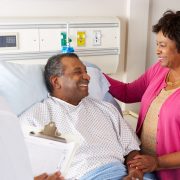
The knee is a complex joint with bones, muscles, soft tissues, ligaments, and tendons working together. If any part of the knee is injured, you are likely to experience pain and might have difficulty walking—or even be unable to walk at all.
For example, the anterior cruciate ligament (ACL) is one of the most frequently injured parts of the knee. Many people assume that a torn ACL means you cannot bear weight on that leg or walk. But if you ask an orthopedic specialist, “Can you walk with a torn ACL?,” the answer is likely to be “yes,” at least in most cases.
However, being able to walk does not necessarily mean you do not have a serious knee injury. And without diagnosis and treatment, knee cartilage can sustain even more damage and put you at risk for chronic knee pain and osteoarthritis.
EmergeOrtho—Triangle Region is here to help if you suspect an ACL tear or any other knee injury, with the most advanced treatment options that will help you Emerge Stronger. Healthier. Better.
How Do You Know If Your ACL Is Torn?
The ACL consists of strong tissue that connects your thigh bone (femur) to your shin bone (tibia). It runs diagonally through the middle of your knee, keeping your shin from slipping out in front of your thigh bone, and allows the knee to function properly, protecting the knee from further damage.
In most cases, injuries occur during sports when athletes land from a jump, change direction, or stop suddenly. Direct hits to the knee can also tear the ACL. For that reason, torn ACLs are common in basketball, football, and skiing. However, they can occur during any activity in which the knee joint unexpectedly twists or hyperextends.
Orthopedists categorize ACL injuries as sprains and evaluate them on a scale of one to three.
- Grade 1 Sprain: This is a mild injury, where the ligament slightly stretches, but the joint is still stable.
- Grade 2 Sprain: Also known as a partial tear, the ligament is overstretched and loose.
- Grade 3 Sprain: The most serious—and common—injury, the ligament is completely separated, and the joint is unstable.
Learn more about the anatomy of the knee and ACL tears.
Some of the signs of a torn ACL include:
- A loud “popping” or series of pops in the knee at the time of injury.
- A feeling that something has snapped or popped in the knee.
- Severe, sudden pain.
- An inability to continue with the activity.
- Decreased range of motion in the knee.
- A feeling of instability in the joint.
Sometimes, a torn ACL can be confirmed via a physical examination by an experienced orthopedic specialist. However, because you can walk with a torn ACL (in many cases), and pain often subsides within a few days, imaging tests are often necessary to confirm the diagnosis and rule out other causes of your symptoms.
Can You Walk with a Torn ACL?
Again, the answer to “can you walk with a torn ACL?’ is “Possibly.” Even a minor injury will make it difficult to put weight on the affected leg, and walking will be painful.
As you heal, it may become easier to walk, but the range of motion in your knee will be limited. Walking with a torn ACL is usually limited to moving in a straight line. You might be able to go up and down stairs, or even jog, but it will be painful and even impossible to pivot, twist, or jump without intense pain. Over time, the pain will often subside, and the knee can feel fine with straight walking, but twisting or turning will often remain difficult.
Walking with a torn ACL can worsen the injury and increase the risk of needing surgery or other more intense treatment. It is best to see an orthopedic specialist as soon as possible for diagnosis and treatment. Treatment usually includes:
- Using the RICE (Rest, Ice, Compression, Elevation) method immediately after the injury to reduce pain and swelling.
- Stabilizing the knee with a brace.
- Walking with crutches to keep you comfortable.
- Performing knee strengthening exercises at home and with the help of a physical therapist.
When Is Surgery Necessary for a Torn ACL?
Although a torn ACL will not heal on its own, surgery is not necessary in every case. Treatment for some elderly patients, people who are not very active, and those with Grade 1 sprains typically includes:
- Rest
- Bracing
- Physical therapy
As long as the knee still has some level of stability, conservative treatment can be effective.
Because a partial or complete tear is more common, a torn ACL usually means surgery is necessary. The ligament cannot be stitched back together; instead, the procedure involves rebuilding the ligament using grafted tissue from another tendon in the leg. After surgery, new tissue grows on the graft, repairing the torn ligament.
Recovery after surgery for a torn ACL can take up to six months. Rehabilitation to restore strength and range of motion to the joint is also necessary.
Getting Help for Knee Injuries
If you hurt your knee, do not automatically assume it is nothing serious because you can still walk, even if it is not extremely painful to do so. Even a serious ACL injury will not necessarily prevent you from walking, so it is vital to see a doctor for an evaluation.
The board-certified team of Sports Medicine orthopedic specialists at EmergeOrtho—Triangle Region is ready to help you heal and get back to doing what you love, so self-schedule an appointment today.







